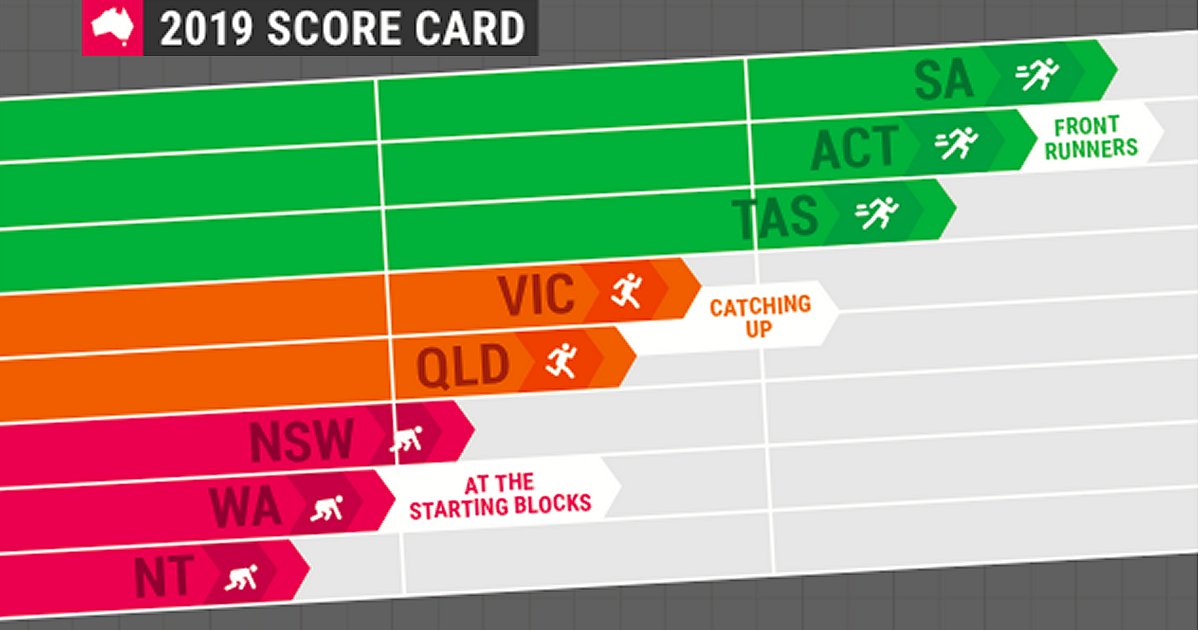The Climate Council’s latest renewable energy scorecard will be released this morning. Here’s a look at some of the facts and figures that will be included in the report.
This will be the fifth annual report card from the Climate Council examining how Australia’s states and territories are faring in making the transition to renewables. This year’s report is titled “State of Play: Renewable Energy Leaders and Losers”.
Overall Rankings And Grades
South Australia has been declared the overall winner, with the ACT and Tasmania not far behind.
- South Australia – A
- ACT – A
- Tasmania – A
- Victoria – B
- Queensland – B
- New South Wales – C
- Western Australia – C
- Northern Territory – C
Wind And Solar Energy Capacity Per Capita (March 2019) Rankings
- ACT – 1.27kW
- South Australia – 1.25kW
- Tasmania – 600W
- Queensland – 380W
- Victoria – 340W
- Western Australia – 280W
- New South Wales – 250W
- Northern Territory – 120W
Percentage Of Households With Solar Panels (Oct 2019) Rankings
- Queensland – 35.7%
- South Australia – 35.0%
- Western Australia – 28.8%
- New South Wales – 20.4%
- Northern Territory – 18.1%
- Victoria – 17.9%
- ACT – 16.1%
- Tasmania – 15.1%
Last year’s scorecard showed the two front-runners Queensland and South Australia with 33% and 32% of households having solar panels installed respectively.
Renewable Electricity (2018) Rankings
- Tasmania – 94.6%
- ACT – 54.1%
- South Australia – 51.2%
- Victoria – 17.3%
- New South Wales – 17.3%
- Queensland – 8.8%
- Western Australia – 8.2%
- Northern Territory – 4.0%
While indicating 54.1% for 2018, the report will note the ACT is on track to achieve 100 percent renewable energy on January 1, 2020.
Renewable Energy Lifters And Leaners
The Climate Council has praised the collective efforts of states and territories while condemning the Federal Government, stating the lack of effective national energy policy has undermined investor confidence in renewable energy.
“States and territories are driving the transition to a renewable energy future, in the face of the Federal Government’s lack of leadership. As a result, several states and territories have declared the intention to go it alone on renewable energy policy,” said Climate Councillor Greg Bourne. “It is time for all states and territories to create their own forums for coordination and move on without the Federal Government.”
Mr. Bourne also accused the Federal Government of going out of its way to attack states working to increase renewable energy uptake.
The figures noted above are only a part of how overall rankings and grades were assigned. This post will be updated with a link to the full “State of Play: Renewable Energy Leaders and Losers” once the report is available today.
UPDATE 10.30AM – The report can be downloaded here.


 RSS - Posts
RSS - Posts



This seems rigged, as yet another attack on WA, like the pillaging of WA’s fair entitlement (equal share per capita) of the GST revenue.
I wonder why the people of WA. having the third-highest proportion of “households with solar panels”, are denigrated to second-last, in the rigged rankings, when the people of WA, are obviously and clearly, making the third-best effort, to implement clean energy usage.
But, then, the ranking is probably done by eastern staters, living it up on the pillaged GST revenue that is WA’s share.
Try checking your individual postcode figs. In my postcode, and in others surrounding mine, over 50% of households have roof-top solar. That might make you feel better.